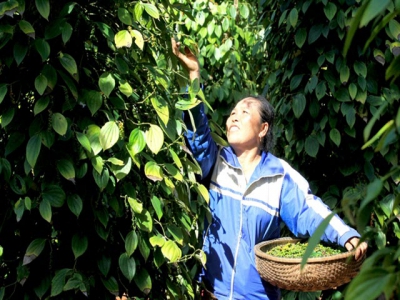Viet Nam unlikely to reach pepper export target this year

Ho Chi Minh City — Việt Nam may not reach its pepper export goal for this year due to many difficulties, according to the Việt Nam Pepper Association (VPA).
Harvesting pepper in Quảng Trị Province. Việt Nam’s pepper exports in the first six months of this year reached 166,812 tonnes, earning $356 million. — VNA/VNS Photo Hồ Cầu
The domestic pepper output is expected to fall, creating more difficulties for the country in reaching the export target of 280,000 tonnes with a total value of US$800 million this year.
VPA Chairman Nguyễn Nam Hải said the COVID-19 pandemic is seriously affecting global trade and the global pepper supply chain is also interrupted in many markets.
In the first quarter, Việt Nam’s pepper exports remained stable but in the second quarter, the COVID-19 outbreak around the world forced countries and territories to implement lockdowns, leading to restrictions on travel and trade activities.
In addition, consumers also cut spending on non-essential products to focus on essential food and health products, causing significant reductions in pepper import demand.
In the first six months, Việt Nam’s pepper exports to China decreased by 21.4 per cent and to India 37.8 per cent.
Especially, Vietnamese pepper exports to Nepal increased sharply in the first quarter but from the end of March, the Nepalese government temporarily suspended imports of some commodities, including pepper, meaning local export enterprises faced difficulties in exporting to this market.
The General Department of Customs reported that Việt Nam’s pepper exports in the first six months of this year reached 166,812 tonnes, earning $356 million, down 5.7 per cent in volume and 21.1 per cent in value over the same period last year.
Of which, the exports in June reached only 21,000 tonnes, a sharp decline of 32 per cent year on year.
Hải said with the developments of COVID-19, the import demand for Vietnamese pepper in some large markets such as India, the US and the EU is expected to continuously decrease.
In addition, climate change and low pepper prices have led to a reduction in pepper output. Việt Nam's total pepper output in 2020 is expected to reach only 240,000 tonnes, down 15 per cent compared to 2019.
This factor will also make it difficult for Việt Nam to reach its export target this year, Hải said.
Trần Phước Hậu, deputy general director of the Trân Châu Import and Export Company, said that the company's two largest export markets are Europe and the US, in addition to some Asian and Middle Eastern countries.
However, due to COVID-19, its pepper exports have decreased significantly since the beginning of March. In addition to the continuous fluctuation of raw pepper prices, most businesses can only export pepper under old export contracts and do not have new export orders.
Therefore, the association has recommended that the local export enterprises should focus on restoring pepper exports to markets which have lifted lockdowns in Asia, such as China, South Korea and Japan. At the same time, they need to boost domestic consumption with processed pepper products.
Việt Nam’s pepper farmers need to link with export enterprises in expanding areas for organic pepper trees. That would ensure Vietnamese pepper has stable output and higher quality to compete with pepper from Brazil and Indonesia. These two countries producing pepper are expected to have high output of pepper in the next crop, putting more pressure on the price of Vietnamese pepper.
Có thể bạn quan tâm
 New opportunities open up for agricultural product processing
New opportunities open up for agricultural product processing Investment in processing technology is helping the agricultural sector recover after the pandemic, as well as opening a window of opportunity for Vietnam
 Vietnam's rice exports may slide after one-month high
Vietnam's rice exports may slide after one-month high Rice exports were the only bright part in the picture of Vietnam’s farm exports in the first six months of the year. However, the achievements
 Bạc Liêu expands cultivation of world’s best rice varieties
Bạc Liêu expands cultivation of world’s best rice varieties The Cửu Long (Mekong) Delta province of Bạc Liêu has decided to expand the cultivation of ST 24 and ST 25, two local rice varieties that rank among the world’s